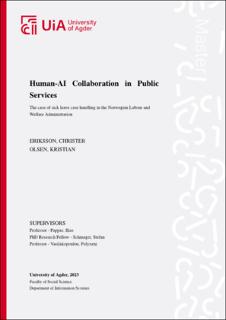| dc.description.abstract | Public service delivery has seen a surge in demand from society in recent years, especially after the Covid-19 pandemic. It is crucial for public service organizations to keep up with digitization efforts to meet these demands. The most important information systems innovation for the public sector is artificial intelligence (AI). Not all processes in public service delivery can be fully automated by AI, requiring human presence to ensure human discretion and fair judgment. This study investigates the needs for human-AI collaboration in public services. To further narrow the study, it focuses on the case of sick leave case handling in the Norwegian Labour and Welfare Administration (NAV). Human-AI collaboration in public services is a field of research that has gained increased interest recently, but there is a need for further research in this area. To help shed more light on this topic, we formulated the following research question:
"What are caseworkers’ needs for Human-AI collaboration in public services?"
To help us answer the research question, we formulated three sub-questions related to the caseworkers’ needs for AI when handling sick leave cases, their expectations for the future working with AI, and how our contributions can facilitate meeting their needs. A case study was conducted, with semi-structured interviews and focus group interviews with 16 public service practitioners as data-gathering methods. The research is set in the organization NAV, specifically in the area of sick leave case handling. We conducted a systematic literature review on the topic of transparency in human-AI interaction, which we found to be a central topic in the human-AI collaboration literature. We found multiple aspects of AI to encompass the topic of transparency, which forms the basis for the background theory used in this study.
Findings show that caseworkers have quite similar needs relating to human-AI collaboration. They think that AI could mostly assist in the internal processes of the organization. Bias in AIs decisions, based on data available, was a concern amongst the caseworkers. The caseworkers suggested that humans should be in the loop to allow more trust in the systems, and thought that not all processes should be automated. Findings point towards simplifying and streamlining caseworkers’ work processes, by using AI-assisted tools in their systems.
Based on the findings and recommendations, we suggest further research into the responsible development and deployment of AI, different government legislations, and how human-AI collaboration differs cross-culturally. From this study, we propose implications for practice in NAV. To leave the human in control, and to improve caseworkers’ decision-making processes, a human-centered approach to human-AI collaboration is suggested. Public sector organizations could streamline and simplify work processes through human-AI collaboration, which could help reach some of the UN’s sustainable development goals. | |
